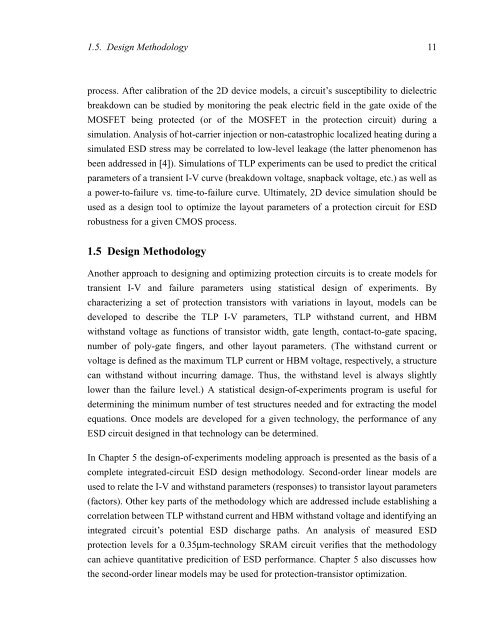characterization, modeling, and design of esd protection circuits
characterization, modeling, and design of esd protection circuits
characterization, modeling, and design of esd protection circuits
Create successful ePaper yourself
Turn your PDF publications into a flip-book with our unique Google optimized e-Paper software.
1.5. Design Methodology 11<br />
process. After calibration <strong>of</strong> the 2D device models, a circuit’s susceptibility to dielectric<br />
breakdown can be studied by monitoring the peak electric field in the gate oxide <strong>of</strong> the<br />
MOSFET being protected (or <strong>of</strong> the MOSFET in the <strong>protection</strong> circuit) during a<br />
simulation. Analysis <strong>of</strong> hot-carrier injection or non-catastrophic localized heating during a<br />
simulated ESD stress may be correlated to low-level leakage (the latter phenomenon has<br />
been addressed in [4]). Simulations <strong>of</strong> TLP experiments can be used to predict the critical<br />
parameters <strong>of</strong> a transient I-V curve (breakdown voltage, snapback voltage, etc.) as well as<br />
a power-to-failure vs. time-to-failure curve. Ultimately, 2D device simulation should be<br />
used as a <strong>design</strong> tool to optimize the layout parameters <strong>of</strong> a <strong>protection</strong> circuit for ESD<br />
robustness for a given CMOS process.<br />
1.5 Design Methodology<br />
Another approach to <strong>design</strong>ing <strong>and</strong> optimizing <strong>protection</strong> <strong>circuits</strong> is to create models for<br />
transient I-V <strong>and</strong> failure parameters using statistical <strong>design</strong> <strong>of</strong> experiments. By<br />
characterizing a set <strong>of</strong> <strong>protection</strong> transistors with variations in layout, models can be<br />
developed to describe the TLP I-V parameters, TLP withst<strong>and</strong> current, <strong>and</strong> HBM<br />
withst<strong>and</strong> voltage as functions <strong>of</strong> transistor width, gate length, contact-to-gate spacing,<br />
number <strong>of</strong> poly-gate fingers, <strong>and</strong> other layout parameters. (The withst<strong>and</strong> current or<br />
voltage is defined as the maximum TLP current or HBM voltage, respectively, a structure<br />
can withst<strong>and</strong> without incurring damage. Thus, the withst<strong>and</strong> level is always slightly<br />
lower than the failure level.) A statistical <strong>design</strong>-<strong>of</strong>-experiments program is useful for<br />
determining the minimum number <strong>of</strong> test structures needed <strong>and</strong> for extracting the model<br />
equations. Once models are developed for a given technology, the performance <strong>of</strong> any<br />
ESD circuit <strong>design</strong>ed in that technology can be determined.<br />
In Chapter 5 the <strong>design</strong>-<strong>of</strong>-experiments <strong>modeling</strong> approach is presented as the basis <strong>of</strong> a<br />
complete integrated-circuit ESD <strong>design</strong> methodology. Second-order linear models are<br />
used to relate the I-V <strong>and</strong> withst<strong>and</strong> parameters (responses) to transistor layout parameters<br />
(factors). Other key parts <strong>of</strong> the methodology which are addressed include establishing a<br />
correlation between TLP withst<strong>and</strong> current <strong>and</strong> HBM withst<strong>and</strong> voltage <strong>and</strong> identifying an<br />
integrated circuit’s potential ESD discharge paths. An analysis <strong>of</strong> measured ESD<br />
<strong>protection</strong> levels for a 0.35µm-technology SRAM circuit verifies that the methodology<br />
can achieve quantitative predicition <strong>of</strong> ESD performance. Chapter 5 also discusses how<br />
the second-order linear models may be used for <strong>protection</strong>-transistor optimization.
















